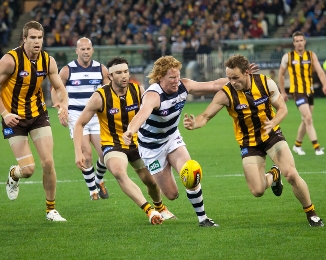01 March 2016
 Researchers at the University of South Australia may have just hit on a revolutionary new approach to defining, monitoring and adjusting the illusive “game style” for football and other field and team sports and it is surprisingly simple.
Researchers at the University of South Australia may have just hit on a revolutionary new approach to defining, monitoring and adjusting the illusive “game style” for football and other field and team sports and it is surprisingly simple.
UniSA Professor of Exercise Science, Kevin Norton, along with honours student Grace Greenham and PhD candidate Adam Hewitt have developed a model to define team performance and playing patterns in field sports and it promises to be a boon for coaches globally.
Using data collected by sports statistics agencies such as Champion or Opta-Pro, as well as some creative new measures, and defining the most important variables in team performance across the offensive and defensive attributes of the game, the model allows coaches to plot performance according to worst and best outcomes.
Professor Norton says “game style” is a term often thrown about in sports commentary and coaching but until now it has never been satisfactorily defined.
“You hear it all the time – players are asked to adapt to a new game style when they move clubs, people talk about attractive game style or copying the game style of a champion team, but no one can tell you what that really means,” he says.
“We’ve developed a generic system to measure and categorise game style that can be applied to just about any field or team sport and we think it is going to be incredibly useful across the world of sports.”
Work done to elucidate the model included an assessment of six AFL football teams tracking performance statistics from the first 14 games of the 2015 season.
“In our research example we plotted play patterns within five key moments or phases of play,” Prof Norton says.
“They ranged from when the teams had complete control of the ball, such as when kicking for goal; during attacking play, such as the passing rate and efficiency of ball movement; right through to defensive play, when teams try to achieve ball recovery via tackling and other strategies, including creating high density around the ball carrier.
“Transition moments are in between offensive and defensive play and involve rapid team reorganisation and ball speed.
“Mapped against other teams performances, or even a weekly performance comparison of the same team will highlight game patterns that can be matched to improvement goals.
“The model works so well that you can see exactly which skills sets need to be improved and, as a tool for training drills and skills improvement sessions, it can be targeted to the specific areas of weakness in a team’s game style.”
And the statistical analysis of AFL teams mapped to the game style model conducted by Prof Norton and his team had some interesting results.
“There were no surprises in the fact that Hawthorn was dominant in all five moments of play - the offensive, defensive and transition moments that we tracked. Their game style measures over the 14 games we looked at, vindicate their position as the 2015 Premiership team,” he says.
“In contrast, Carlton was poor in four of the five moments of play – their only above average moment being in the ability to move the ball quickly.
“Port Adelaide was above average in four of the five moments of play, with particular strength in goal accuracy but not in being in a good position to kick for goals. The analysis showed that what really let Port Adelaide down was poor passing efficiency and slow ball speed during transitions from defence or offence.”
Prof Norton says the model allows for the inclusion of as many or as few variables within these five moments of play that a coach might want to measure.
Media contact: Michèle Nardelli office +61 883020966 mob 0418823673 email michele.nardelli@unisa.edu.au



